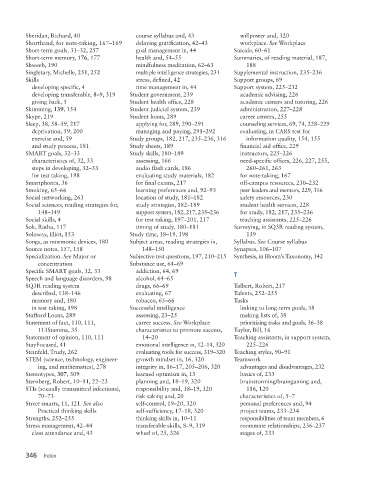Page 383 - Keys to College Success
P. 383
Sheridan, Richard, 40 course syllabus and, 43 willpower and, 320
Shorthand, for note-taking, 167–169 delaying gratif cation, 42–43 workplace. See Workplace
Short-term goals, 31–32, 257 goal management in, 44 Suicide, 60–61
Short-term memory, 176, 177 health and, 54–55 Summaries, of reading material, 187,
Shweeb, 190 mindfulness meditation, 62–63 188
Singletary, Michelle, 251, 252 multiple intelligence strategies, 231 Supplemental instruction, 235–236
Skills stress, def ned, 42 Support groups, 69
developing specif c, 4 time management in, 44 Support system, 225–232
developing transferable, 8–9, 319 Student government, 239 academic advising, 226
giving back, 5 Student health off ce, 228 academic centers and tutoring, 226
Skimming, 139, 154 Student judicial system, 239 administration, 227–228
Skype, 219 Student loans, 289 career centers, 255
Sleep, 38, 58–59, 217 applying for, 289, 290–291 counseling services, 69, 74, 228–229
deprivation, 59, 200 managing and paying, 291–292 evaluating, in CARS test for
exercise and, 59 Study groups, 182, 217, 235–236, 316 information quality, 154, 155
and study process, 181 Study sheets, 189 f nancial aid off ce, 229
SMART goals, 32–33 Study skills, 180–189 instructors, 225–226
characteristics of, 32, 33 assessing, 166 need-specif c off ces, 226, 227, 255,
steps in developing, 32–33 audio f ash cards, 186 260–261, 263
for test taking, 198 evaluating study materials, 182 for note-taking, 167
Smartphones, 36 for f nal exams, 217 off-campus resources, 230–232
Smoking, 65–66 learning preferences and, 92–93 peer leaders and mentors, 229, 316
Social networking, 263 location of study, 181–182 safety resources, 230
Social sciences, reading strategies for, study strategies, 182–189 student health services, 228
148–149 support system, 182, 217, 235–236 for study, 182, 217, 235–236
Social skills, 4 for test taking, 197–201, 217 teaching assistants, 225–226
Sok, Ratha, 117 timing of study, 180–181 Surveying, in SQ3R reading system,
Soloway, Eliot, 153 Study time, 18–19, 198 139
Songs, as mnemonic devices, 180 Subject areas, reading strategies in, Syllabus. See Course syllabus
Source notes, 157, 158 148–150 Synapses, 106–107
Specialization. See Major or Subjective test questions, 197, 210–215 Synthesis, in Bloom’s Taxonomy, 142
concentration Substance use, 64–69
Specif c SMART goals, 32, 33 addiction, 64, 69 T
Speech and language disorders, 98 alcohol, 64–65
SQ3R reading system drugs, 66–69 Talbert, Robert, 217
described, 138–146 evaluating, 67 Talents, 252–255
memory and, 180 tobacco, 65–66 Tasks
in test taking, 198 Successful intelligence linking to long-term goals, 38
Stafford Loans, 289 assessing, 23–25 making lists of, 38
Statement of fact, 110, 111, career success. See Workplace prioritizing tasks and goals, 36–38
113Stamina, 35 characteristics to promote success, Taylor, Bill, 16
Statement of opinion, 110, 111 14–20 Teaching assistants, in support system,
StayFocused, 41 emotional intelligence in, 12–14, 320 225–226
Steinfeld, Trudy, 262 evaluating tools for success, 319–320 Teaching styles, 90–91
STEM (science, technology, engineer- growth mindset in, 16, 320 Teamwork
ing, and mathematics), 278 integrity in, 16–17, 205–206, 320 advantages and disadvantages, 232
Stereotypes, 307, 309 learned optimism in, 15 basics of, 233
Sternberg, Robert, 10–11, 22–23 planning and, 18–19, 320 brainstorming/braingaming and,
STIs (sexually transmitted infections), responsibility and, 18–19, 320 116, 120
70–73 risk-taking and, 20 characteristics of, 5–7
Street smarts, 11, 121. See also self-control, 19–20, 320 personal preferences and, 94
Practical thinking skills self-suff ciency, 17–18, 320 project teams, 233–234
Strengths, 252–255 thinking skills in, 10–11 responsibilities of team members, 6
Stress management, 42–44 transferable skills, 8–9, 319 roommate relationships, 236–237
class attendance and, 43 wheel of, 25, 326 stages of, 233
346 Index

